|
|
|
Sort Order |
|
|
|
Items / Page
|
|
|
|
|
|
|
| Srl | Item |
| 1 |
ID:
147804
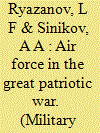

|
|
|
|
|
| Summary/Abstract |
The authors assess and analyze events of the Great Patriotic War involving aviation. The article shows how views on employing the Air Force in warfare changed, and highlights the role of the battle for air superiority.
|
|
|
|
|
|
|
|
|
|
|
|
|
|
|
|
| 2 |
ID:
132462
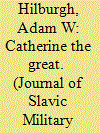

|
|
|
|
|
| Publication |
2014.
|
| Summary/Abstract |
The campaigns of Catherine the Great against the Ottoman Empire in the 1770s reveal key characteristics of operational art. Catherine's campaigns serve as an example of lesser-known conflicts that fulfill the necessary conditions of the numerous schools of thought on operational art. The operational commander, Rumiantsev, developed an operational plan to meet the strategic directives developed by Catherine's permanent 'Council attached to the Court'. His armies used successive tactical actions to engage Turkish maneuver forces and lay siege to its fortresses. The armies were organized into combined arms corps that coordinated to remain mutually supporting with the ability to concentrate at the decisive point when required and the Russian armies to not fight in the linear methods of its Western counterparts. Additionally, the armies and corps conducted distributed operations throughout the theater of war, at times hundreds of kilometers separating them. More importantly, Rumiantsev arranged tactical actions to achieve strategic objectives, the most important part of the definition of operational art. These successive, distributed operations should satisfy the schools of thought that consider Napoleon's campaigns as operational art, but those that understand operational art beginning with Grant and Moltke may see that the Russian Campaigns on the frontiers also move beyond the classical strategy of a single point
|
|
|
|
|
|
|
|
|
|
|
|
|
|
|
|
| 3 |
ID:
186528
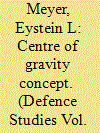

|
|
|
|
|
| Summary/Abstract |
This article applies grounded theory and epistemological, teleological, ontological, and methodological (ETOM) lenses to describe the prevalent contemporary theories of the centre of gravity concept, originated by Carl von Clausewitz. These include the theories of John Warden, Joe Strange & Richard Iron, Antulio Echevarria II, Milan Vego, Dale Eikmeier, and Jacob Barfoed. The article then compares the theories across 14 deduced theoretical aspects and produces a comparison matrix, that can be used as an analytical tool, and discusses implications as guidance for further research and doctrine development. The article argues that the term “centre of gravity” is polluted, and that the application of the term in military planning and doctrines requires careful attention to the specific theory being applied, so that logical consistency and clear, accurate communication is achieved. Alternatively, the concept may be removed from doctrine altogether, renovated with inclusion of a new unpolluted term, or reconstructed with removal of the centre of gravity, leaving a “critical factor analysis” concept behind. This article also provides a level of granularity to the debate about the concept, that renders critics like Paparone & Davis Jr and Zweibelson partly irrelevant and can provide a more nuanced and qualitative basis for future discussion.
|
|
|
|
|
|
|
|
|
|
|
|
|
|
|
|
| 4 |
ID:
157629
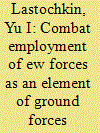

|
|
|
|
|
| Summary/Abstract |
This paper describes prerequisites for making the Electronic Warfare forces and assets of combined arms formations into a part of Ground Forces, and formulates requirements for the basics of EW forces operational art.
|
|
|
|
|
|
|
|
|
|
|
|
|
|
|
|
| 5 |
ID:
140434
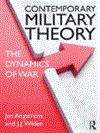

|
|
|
|
|
| Publication |
Oxon, Routledge, 2015.
|
| Description |
viii, 205p.: ill.pbk
|
| Standard Number |
9780415643047
|
|
|
|
|
|
|
|
|
|
|
|
Copies: C:1/I:0,R:0,Q:0
Circulation
| Accession# | Call# | Current Location | Status | Policy | Location |
| 058283 | 355.0201/ANG 058283 | Main | On Shelf | General | |
|
|
|
|
| 6 |
ID:
191503
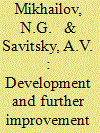

|
|
|
|
|
| Summary/Abstract |
This paper addresses topical issues of the development of the art of war as reflected in the works of great military theorists and commanders from the time of Sun Tzu until now.
|
|
|
|
|
|
|
|
|
|
|
|
|
|
|
|
| 7 |
ID:
175119
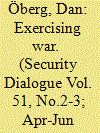

|
|
|
|
|
| Summary/Abstract |
This article analyzes how contemporary military training and exercises shape and reify specific modalities of war. Historically, military training has shifted from being individual- and experience-oriented, towards becoming modelled into exercise environments and practices. Drawing on semi-structured interviews with military officers, exercise controllers, and war-game designers, the article distinguishes between tactical training, characterized by military functions embodied through weapon platforms in a demarcated battlespace, and operational training, characterized by administrative and organizational processes embodied through self-referential staff routines. As military exercises integrate the tactical and operational dimensions into a model for warfare, they serve as blueprints for today’s battles at the same time as they perpetuate a martial viewpoint of the world. As a result, preparations for potential future conflicts constitute a fertile ground for apprehending the becoming of war.
|
|
|
|
|
|
|
|
|
|
|
|
|
|
|
|
| 8 |
ID:
072399
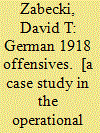

|
|
|
|
|
| Publication |
London, Routledge, 2006.
|
| Description |
xxiv, 408p.Hbk
|
| Standard Number |
0415356008
|
|
|
|
|
|
|
|
|
|
|
|
Copies: C:1/I:0,R:0,Q:0
Circulation
| Accession# | Call# | Current Location | Status | Policy | Location |
| 051356 | 940.434/ZAB 051356 | Main | On Shelf | General | |
|
|
|
|
| 9 |
ID:
130290
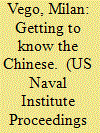

|
|
|
| 10 |
ID:
190721
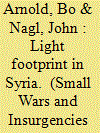

|
|
|
|
|
| Summary/Abstract |
Special Operations Forces (SOF) played an important role in defeating the Islamic State (ISIS) physical caliphate in Syria. Acting as a force multiplier, SOF successfully mobilized, armed, supplied, and directed an indigenous guerrilla force across northern Syria against a numerically superior entrenched enemy. This effort was underpinned by a flexible operational approach that adapted operational art to the unique characteristics of unconventional warfare. This paper provides a case study on the conflict with ISIS in Syria, focusing on the first phase of the campaign from 2014 until 2016, examining the elements of operational art which had the most significant impact on the outcome of the conflict. The application of operational art throughout the campaign sought to preserve and strengthen the friendly center of gravity – the Syrian Defense Forces, or SDF – by improving access to critical capabilities, controlling tempo, recognizing culmination criteria, and properly phasing operations and resources. SOF’s practice of sustained engagement garnered influence with the SDF and provided situational awareness to key decision makers, connecting tactics to strategy, engendering mutual trust, and allowing the agility that led to battlefield success.
|
|
|
|
|
|
|
|
|
|
|
|
|
|
|
|
| 11 |
ID:
143711
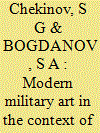

|
|
|
|
|
| Summary/Abstract |
The authors discuss military systematology, a complex subject of modern science that is highly relevant and much in demand in our days, and its influence on modern military art.
|
|
|
|
|
|
|
|
|
|
|
|
|
|
|
|
| 12 |
ID:
146916
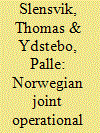

|
|
|
|
|
| Summary/Abstract |
The second revision of the Norwegian Joint Operational Doctrine (NJOD) is an example of how a small state within the NATO framework presents a national ambition of conducting joint operations. Even if NATO doctrine is the cornerstone for the application of military force in Norway, there are some unique conditions and ambitions that Norway has chosen to put into its own doctrine. With the revision, Norway has institutionalized and formalized the doctrine process based upon the experience from earlier efforts and the NATO procedures. It has established a process that ensures a continuous doctrine cycle with few resources and can easily draw on more resources in a project-based development if need be. The process is discussed on the basis of the official minutes from the relevant meetings. This gives a unique insight in the process, and the challenges and solutions a small nation meets in creating national doctrines.
|
|
|
|
|
|
|
|
|
|
|
|
|
|
|
|
| 13 |
ID:
145838
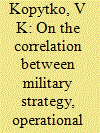

|
|
|
|
|
| Summary/Abstract |
A new look at the Russian military art elements - military strategy, operational art, and tactics. Correlation is substantiated.
|
|
|
|
|
|
|
|
|
|
|
|
|
|
|
|
| 14 |
ID:
121645
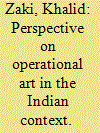

|
|
|
| 15 |
ID:
118337
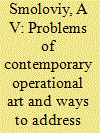

|
|
|
|
|
| Publication |
2012.
|
| Summary/Abstract |
The paper sets out to analyze current trends in the nature of warfare and pinpoint the main problems of modern operational art while suggesting solutions.
|
|
|
|
|
|
|
|
|
|
|
|
|
|
|
|
| 16 |
ID:
148351
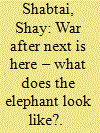

|
|
|
|
|
| Summary/Abstract |
A comprehensive paradigm of future wars can be defined, and is called in this article “Extended conflicts.” These can be characterized by strategic attrition, to which all national resources and all possible international legitimacy are mobilized, in order to achieve a resolution by transformation of the opponent. The use of military force in this kind of conflict is limited. The understanding that we are facing an era of extended conflicts will improve the way it is utilized.
|
|
|
|
|
|
|
|
|
|
|
|
|
|
|
|
| 17 |
ID:
189430
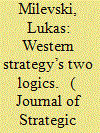

|
|
|
|
|
| Summary/Abstract |
Classical strategy as a concept encompasses two different logics (instrumentality and adversariality) as well as two different modes (decision-making and performance). In modern strategy, these modes have been on diverging paths, with varying interpretations privileging one logic above the other. Game theory focuses on decision-making, but encompasses both adversariality and instrumentality. Operational art focuses on performance, but in an adversarial context. The ends, ways, means model emphasises performance in an instrumental context. Each is imbalanced and inadequate when faced with the challenge of comprehending and controlling war. Strategic studies must make a return to balanced interpretations of strategy.
|
|
|
|
|
|
|
|
|
|
|
|
|
|
|
|
|
|
|
|
|